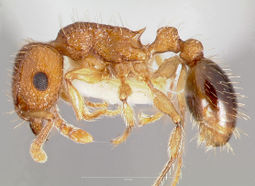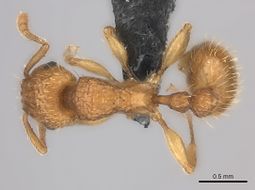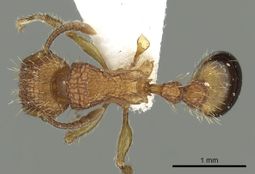Key to Afrotropical Tetramorium bicarinatum species group
This worker key is based on Bolton (1980)[1]
You may also be interested in
- Tetramorium bicarinatum species group
- Afrotropical Tetramorium species groups
- Key to Afrotropical Tetramorium species groups
- Tetramorium
1
- Mandibles longitudinally sculptured ..... Tetramorium bicarinatum
- Mandibles smooth with scattered pits, not at all longitudinally striate or rugulose . . . . . 2
2
return to couplet #1
- Head and mesosoma light yellow to bright orange in colour . . . . . 3
- Head and mesosoma dull brown to black in colour . . . . . 6
3
return to couplet #2
- Uniformly coloured species with head, mesosoma and gaster the same, or the gaster slightly lighter in shade than the head and mesosoma . . . . . 4
- Bicoloured species with head and mesosoma yellow to orange but the gaster much darker, very dark brown to black . . . . . 5
4
return to couplet #3
- Basigastral costulae feeble, not sharply defined. Head relatively narrower, CI 78-81. Small species with HW 0.56-0.70 (usually < 0.65). PW 0.50 or less ..... Tetramorium phasias
- Basigastral costulae distinct, sharply defined. Head relatively broader, CI 83-87. Larger species with HW 0.70-0.98 (usually > 0.80). PW 0.55 or more ..... Tetramorium notiale
5
return to couplet #3
- Dorsum of postpetiole strongly reticulate-rugose ..... Tetramorium cristatum
Dorsum of postpetiole smooth or at most with 1-3 faint longitudinal rugulae..... Tetramorium peutli
6
return to couplet #2
- Postpetiole smooth and shining or at most with faint superficial markings on disk, never reticulate-rugose or coarsely punctulate ..... Tetramorium pullulum
- Postpctiole reticulate-rugose, coarsely reticulate-punctate, or both . . . . . 7
7
return to couplet #6
- Propodeum armed with a pair of minute triangular teeth, much shorter than the metapleural lobes ..... Tetramorium emeryi
- Propodeum armed with a pair of spines which are much longer than the metapleural lobes . . . . . 8
8
return to couplet #7
- Dorsal alitrunk with a strongly raised unbroken sharp transverse crest at the junction of the pronotum and mesonotum. Large species. HW > 0.85 ..... Tetramorium gazense
- Dorsal alitrunk either without such a crest or with a feeble, broken and meandering transverse ridge. If the latter then smaller species with HW < 0.70 . . . . . 9
9
return to couplet #8
- Petiole in profile with the posterodorsal angle projecting and overhanging the posterior face, the node in dorsal view longer than broad. Smaller species with relatively long scapes HW < 0.70, SI > 80 ..... Tetramorium amentete
- Petiole in profile with the posterodorsal angle not projecting, not overhanging the posterior face; the node in dorsal view broader than long. Larger species with relatively short scape HW > 0.80. SI < 80..... Tetramorium erectum
References
<References>





























